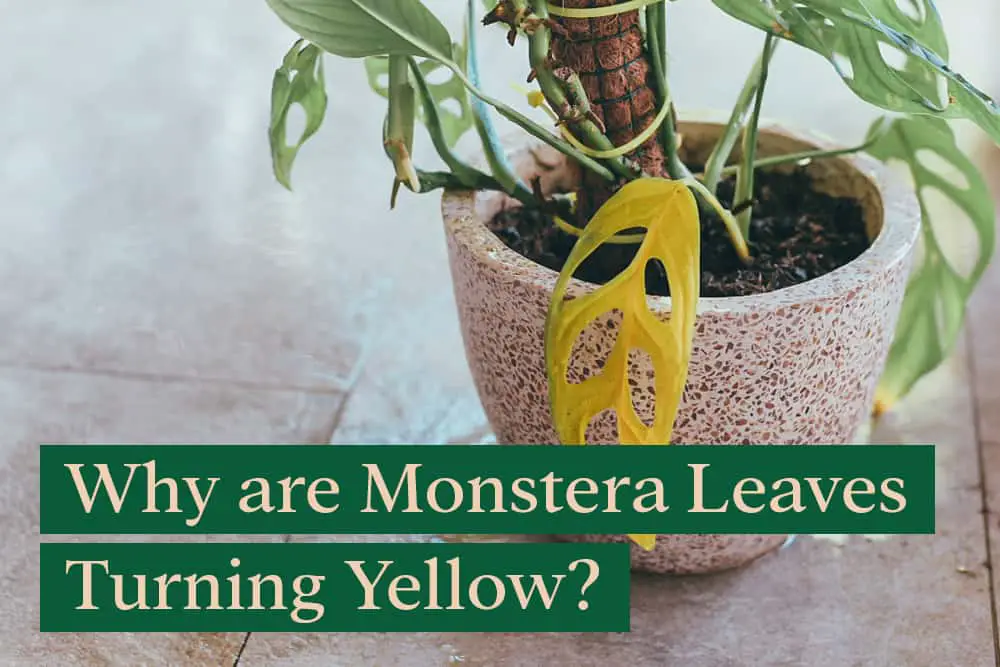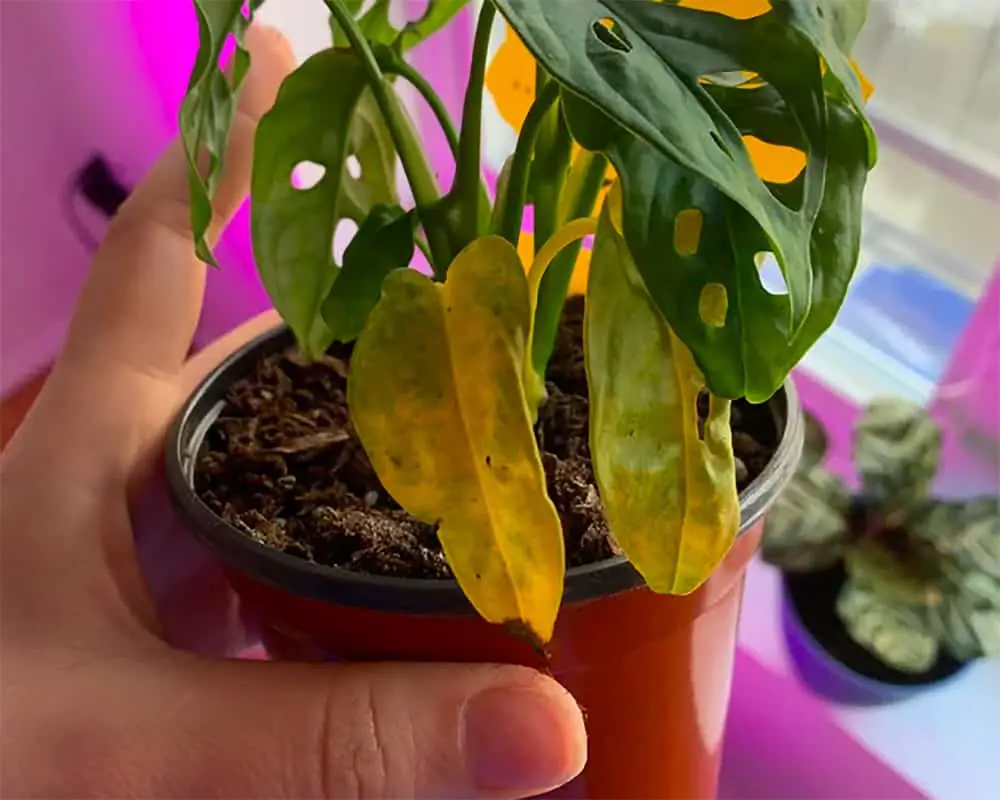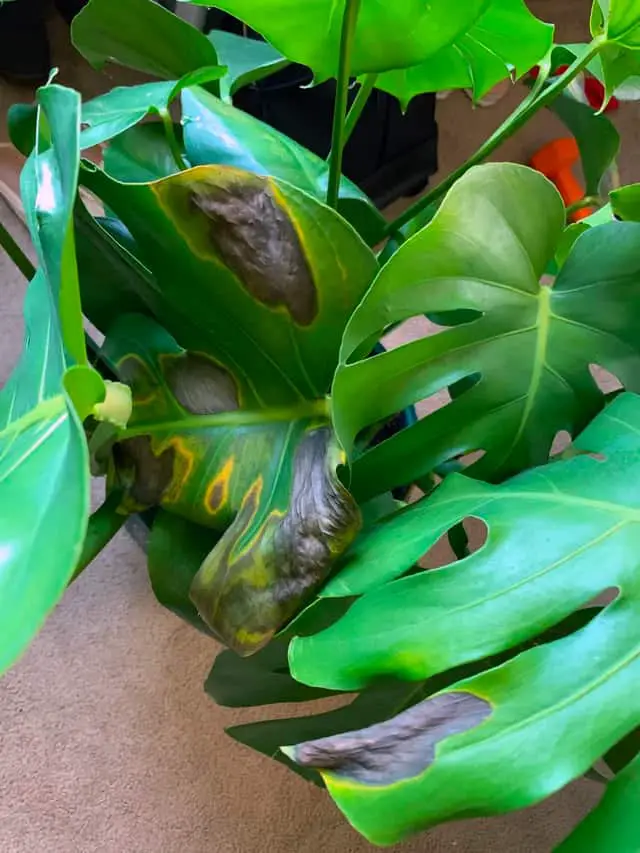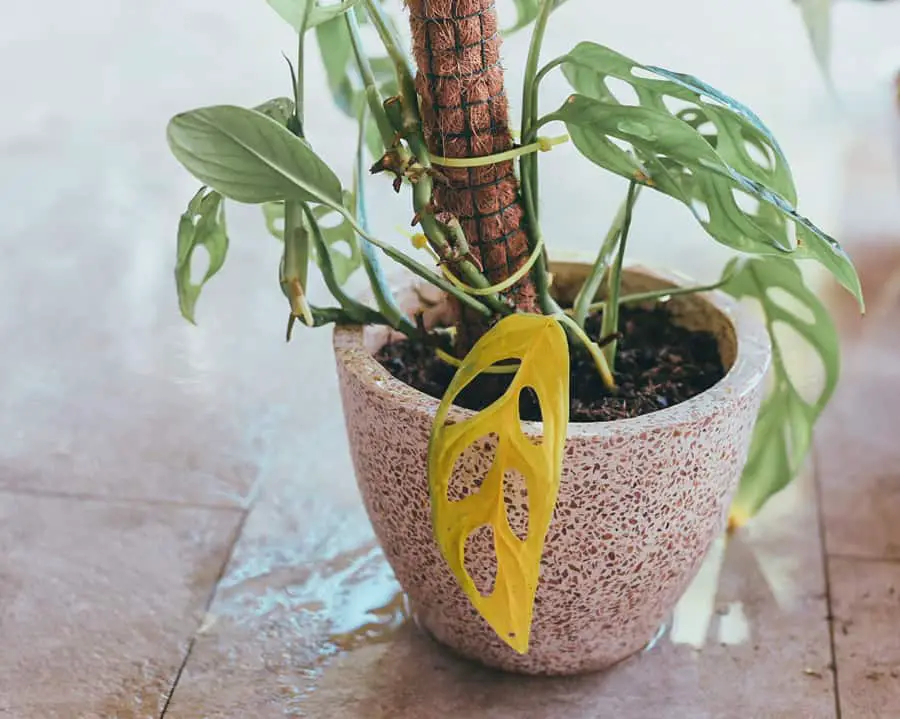
“Help! I think my Monstera is dying! Its leaves are turning yellow and I don’t know what to do!”
Improper watering, light, and fertilizer or stress from temperatures and repotting may all cause Monstera’s leaves to turn yellow. You should never rule out factors such as pest infestation and natural causes as well.
You will need to thoroughly examine your Monstera to determine exactly which issue is causing this yellowing.
Keep reading to find out how to save your Monstera!
Also Read: Monstera Care 101: Complete Guide for First Time Owners
Reasons why monstera leaves turn yellow
Let’s get into the various reasons why a monstera plant’s leaves could turn yellow. There are seven main causes:
1. Watering Problem

Monsteras can be finicky when it comes to water. They come from the rainforest, so they do not like to dry out. But they are also susceptible to root rot if exposed to too much water for too long.
Either of these could cause your Monstera to start turning yellow, so it is vital to sift through your Swiss Cheese plant to find the correct diagnosis.
Overwatering
The first thing you should do if you notice your Monstera’s leaves turning yellow is to check the soil for excess moisture. Just stick your finger into the dirt.
- Is the soil wet?
- Does it feel soggy?
- Does it smell kind of funky or rotten?
If so, your Swiss Cheese plant is most likely suffering from root rot caused by overwatering and will need to be fully repotted. You can refer to our guide here for more detailed instructions.
An overwatered Monstera will droop, develop brown spots on its leaves, and result in yellowing of the leaves. Its soil will take a long time to dry out and may develop a fungus on top.
Remember that overwatering is caused by watering too frequently and water-retentive soil, not by how much water you give it at one time.
When you water your Monstera, you should first check the soil to make sure it is not already too moist, then water the soil until moisture starts to run out of the bottom drainage hole.
Because root rot can quickly kill your Monstera, it is important to check for this disease before doing any care or maintenance, especially before you water it, as that could cause the issue to worsen.
Underwatering
Too little water can also cause your Monstera’s leaves to start turning yellow. Thankfully, this is an easy fix and much less likely to kill your Monstera.
So you stuck your finger in the soil, and it came back bone dry. Your Monstera is thirsty!
An underwatered Monstera will show it in its leaves by drooping, yellowing, curling, and ultimately turning light brown and crispy.
Because the soil is so dry, it will need extra thorough watering. You should transport your plant somewhere you can give it lots of water, like outside with a hose or in the shower. If your Monstera is enormous, you may need help from a friend to carry it.
Shower your Monstera until water starts to run out the bottom of the pot, then keep going for a little longer. When the soil dries out for too long, it can become hydrophobic, meaning it will not absorb the water as well.
After this thorough watering, keep an eye on the yellow leaves and the soil moisture. You may need to adjust your Monstera’s watering schedule to be more frequent.
If more leaves start to turn yellow even after you’ve given them enough water, you may have another issue like pests that will need to be taken care of.
2. Temperature Stress
Monsteras are true rainforest plants. They do not know the meaning of Winter, and therefore do not like the cold.
Monstera plants will stop growing once temperatures drop below 50°F (10°C), and the leaves will start to turn yellow or take damage when the temperature gets closer to freezing.
They will also become stressed when exposed to extreme heat or direct, scorching sunlight. In the jungle, they live in the understory, climbing up trees that protect their leaves from the harsh sun.
Any temperature stress will cause the Monstera’s affected leaves to turn yellow, crispy, or brown. This stress does not necessarily start with older or younger leaves, but the younger, more tender leaves may be more susceptible to temperature stress.
If you notice your Monstera suffering from yellow leaves, take a look at its location:
- Is it next to a southwest-facing window where it gets harsh afternoon sun?
- Is it next to a cold, drafty window in the Winter?
- Is it next to the hot radiator?
Any of these sources of extreme temperature can stress your Monstera out! It would be best if you moved your Monstera a few feet away from the offending source to a location where the temperature will be more stable.
3. Repotting Stress
Did you repot your Monstera into a new home recently? Its yellow leaves may be caused by repotting stress.
Monsteras tend to be sensitive after transplant. The stress here can be caused by the roots being exposed for too long, a change in soil, or even repotting at the wrong time of year (late winter to early spring is best).
A Monstera experiencing transplant shock will droop its leaves and petioles; it will look like it needs watering. Its leaves may begin to turn yellow, starting with the oldest leaves.
Its leaves turn yellow because the Monstera is trying to conserve nutrients and water after the traumatic event. It will eventually bounce back to normal, and it will be even happier in its new pot.
You can help reduce your Monstera’s stress after transplant by putting it back in the same location and continuing with the same watering schedule. Too much light or water (or too little of either) will exacerbate the transplant shock.
Do not fertilize until it has recovered and started growing again. If it seems dry even after regular watering, you can give it a little extra humidity.
4. Improper Light
Just like with water and temperature, Monsteras don’t like extremes when it comes to light.
They can develop yellowing leaves if they receive improper light, whether too much or too little. They thrive in bright, indirect light.
Luckily, this is an easy fix!
Too much light: Leaf Burn

Like I mentioned earlier, Monsteras do not naturally live in direct sunlight. Too much direct light on the leaves will burn them.
When a Monstera leaf gets burned from too much light, the burned spot will turn brown (or black) and crispy, and the surrounding areas on the leaf will become yellow.
Depending on how much of the leaf has burned, the whole leaf may or may not die and fall off.
This is more likely to occur if your Monstera sits in front of a south– or west-facing window. You can prevent leaf burn by moving your Monstera a few feet away from the bright window.
Too little light
This one gets a little tricky.
Not getting enough light will not directly cause your Monstera to develop yellow leaves, but that can be a secondary symptom from (you guessed it) overwatering.
When a Monstera doesn’t get enough light, its growth slows down. This means it doesn’t need as much water or fertilizer. It is much easier to overwater your Monstera in these conditions, which will cause the leaves to turn yellow.
You should have already checked your Monstera’s soil. If you haven’t, do it now!
Other symptoms of light deficiency include the following:
- Etoliation—extended stem reaching for the light, looks leggy or spindly
- Smaller leaves with less fenestration (holes and splits) or none at all
- Slow growth
- Stem leaning toward or away from the window
- Soil takes a long time to dry out in between waterings
If your Monstera exhibits these symptoms and has started to develop yellow leaves, you need to check its roots for rot by removing it from the pot.
This may cause some stress to your Monstera, but it can become even more stressed if root rot is left to spread, so it is worth it.
If it is indeed root rot, you will need to repot your Monstera into fresh soil.
To prevent future overwatering caused by insufficient light, you should try to find a new home for your Monstera closer to a south– or west-facing window. If that is not possible, you should consider purchasing a grow light for it.
5. Nutrient Problem
An imbalance in your monstera’s fertilizer can also cause yellowing leaves.
This can happen from too much fertilizer, which will cause a salt burn to the plant, or a nutrient deficiency.
Each of these has other specific symptoms you should look out for to find a correct diagnosis.
Overfertilization
It would be best to feed your Monstera every few weeks to keep it healthy and strong during the growing season. Monsteras prefer a well-balanced fertilizer.
Overfertilization occurs if too many nutrient salts accumulate in the soil. These will pull water away from the plant’s roots in a process known as reverse osmosis.
They can also alter the soil’s acidity. Too much salt in the soil will cause what is known as salt burn, a result of chemical dehydration.
Is overfertilization causing your Monstera’s leaves to turn yellow? Look for these other symptoms of overfertilization:
- A white crust of excess fertilizer on top of the soil
- Edges of leaves turning brown and crispy
- Lowest & oldest leaves turning yellow
- Slow growth
Overfertilization is easy to fix.
Once you have determined that this is the cause of your Monstera’s yellow leaves, you need to give it a good watering to flush all the excess nutrient salts from the soil.
Just like you would do if your plant was underwatered, flush the soil thoroughly in the shower or outside with a hose until the water runs freely from the pot’s bottom drainage.
You may want to wait a little longer than usual before fertilizing your Monstera again, as the soil will probably still have enough nutrients hanging around.
To prevent future overfertilization, you should reduce the amount and/or frequency of fertilizer applications for your Monstera. Consider switching to a gentle, organic fertilizer. These have a lower concentration of macronutrients and are much less likely to cause a salt burn.
Nutrient Deficiency
On the other hand, your Monstera may be suffering from a nutrient deficiency. When is the last time it got fertilizer or fresh soil? If you can’t remember, you should feed your Monstera soon!
There are three primary nutrients (macronutrients) that all plants need: Nitrogen, Phosphorous, and Potassium. Each of these affects a different biological function within the plant, and a deficiency in any one of them will affect your Monstera differently.
With a nitrogen deficiency, your Monstera will experience stunted growth. Its leaves will display chlorosis, meaning they will grow lighter, with the oldest leaves on the bottom turning entirely yellow.
A phosphorous deficiency in your Monstera will also cause stunted growth. As the condition worsens, the leaves and stems may darken and develop a reddish or purple discoloration. This does not cause yellowing leaves.
A potassium deficiency in your Monstera will cause browning or burning at the leaf edges and chlorosis in between the leaf veins. This yellowing will begin with the oldest leaves as the plant redistributes its low potassium to the younger leaves.
As you can see, your Monstera’s yellow leaves may be caused by a deficiency of either Nitrogen or Potassium. You should rule out other potential causes first, as this is less common and the least likely to kill your Monstera.
If you have determined that your Monstera has a nutrient deficiency, you should feed it with a well-balanced, organic fertilizer and consider top-dressing with fresh soil or worm castings.
6. Pests & Diseases
One of the worst feelings is knowing that some kind of pest is attacking your beautiful Monstera!
There are three diseases you should consider if your Monstera’s leaves are yellowing: anthracnose, fungal leaf spots, and powdery mildew.
Each of these has specific symptoms so that you can diagnose them accurately.
Anthracnose
Anthracnose is a fungal disease that starts with yellow or brown spots on the leaves. As the disease progresses, the yellow areas will turn brown, and the splotches will spread.
The discoloration can spread inward to consume the entire leaf. Anthracnose can also produce brown, cankerous lesions on the stem.
Anthracnose spreads more rapidly in damp conditions such as in the rain or when a concerned plant mom frequently mists the leaves of a suffering Monstera.
You must remove the infected plant, or else the disease will continue to spread. Use a pair of sharp pruning shears to cut off all affected leaves and stems. Disinfect your shears in between each cut by dipping them in rubbing alcohol or peroxide.
You may also spray your Monstera with a copper-based fungicide after cutting away the infected areas, just in case you missed some that hadn’t started showing symptoms yet.
Fungal leaf spots
Unlike anthracnose, a fungal leaf spot is when a fungus starts to eat away at the leaf from the outside.
The fungus can cause a cluster of yellowing spots on the leaf. In the center of the yellow ring will be a black or brown fungal dot. More significant defects may start to look like concentric circles.
If you hold a leaf with fungal spots up to the light, the plant tissue around the edge of the spot may appear wet. This is because the fungus has already started to digest that part of the leaf.
You must remove any infected tissue to prevent further spread. Don’t worry; by keeping your Monstera happy, you’re making sure that it will live to produce more leaves in the future. Then use a copper-based fungicide to kill off any extra fungus that may still be present.
You can help prevent fungal issues by increasing the airflow around your Monstera, especially if you are running a humidifier nearby.
Do not run the humidifier or mist your Monstera later in the day, as water left overnight will be an invitation to future fungal infections.
Powdery mildew
You can identify Powdery mildew quickly as the fungus produces a white, powdery-looking coating on the leaf. When left unchecked, this disease will cause the leaves to dry out and turn yellow.
Treatment for this disease is the same as for other fungal infections. Remove and discard affected sections of the plant.
Use a fungicide to kill whatever’s left. (You can use neem oil for powdery mildew.) Reduce moisture and increase airflow.
You should isolate the affected plant for any kind of pest or fungal infection so that it does not spread to your other houseplants.
7. Natural process

Sometimes a yellow leaf is just a yellow leaf. As your Swiss Cheese plant grows, its new leaves get bigger. It doesn’t make sense to keep putting effort into a tiny, old leaf that doesn’t photosynthesize as much as a new one.
So the plant will take back any nutrients from that old leaf before letting it fall off. This will produce chlorosis and yellowing of the leaf.
If your Monstera only has one yellow leaf all the way down at the bottom and the rest of the plant looks healthy and is growing strong, you don’t have anything to worry about.
Can Yellow leaves turn green again?
Once a leaf turns yellow it will not go back to being green. Your plant will need to put energy into producing a new leaf.
Sometimes a yellowing leaf will still have green sections. If you don’t like the yellow or brown parts, you may cut them off and leave just the green part.
Should I Cut Yellow Leaves off Monstera?
If a disease like a fungus causes the yellowing of the leaves, those affected areas should be immediately removed and thrown out.
However, when the yellowing are caused by root rot or transplant shock, you should leave the plant’s leaves until the leaf is fully dead. Your Monstera will absorb essential nutrients from that leaf as it dies, and cutting it off too soon would exacerbate the stress.
